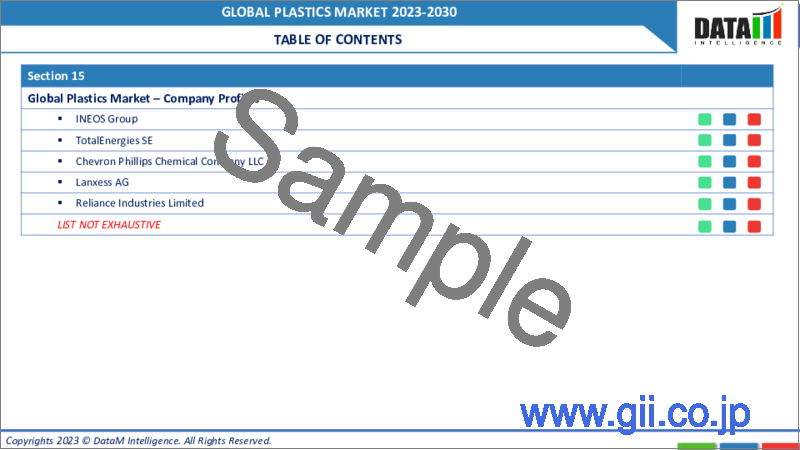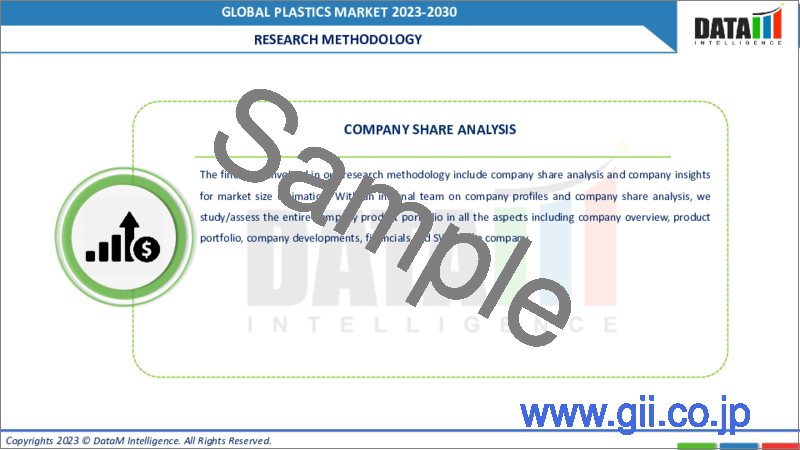|
|
市場調査レポート
商品コード
1297764
プラスチックの世界市場-2023-2030年Global Plastics Market - 2023-2030 |
||||||
カスタマイズ可能
適宜更新あり
|
|||||||
| プラスチックの世界市場-2023-2030年 |
|
出版日: 2023年06月15日
発行: DataM Intelligence
ページ情報: 英文 195 Pages
納期: 即日から翌営業日
|
- 全表示
- 概要
- 目次
市場概要
世界のプラスチック市場は2022年に5,255億米ドルに達し、2030年には6,760億米ドルに達すると予測され、予測期間2023-2030年のCAGRは3.2%で成長します。世界のプラスチック市場にとって最も重要な新興アプリケーションの1つは、3Dプリンティングの台頭です。多くのメーカーが積層造形を中心に生産装置の設計を始めています。
世界のプラスチック市場は、新しいプラスチック複合材料が航空宇宙、生物医学、自動車工学の分野でますます利用されるようになり、先端技術産業からの需要が高まることが予想されます。例えば、自動車メーカーのアウディは2022年11月、同社の電気自動車Q8 e-tronのシートベルトのバックルを再生プラスチックから製造すると発表しました。
世界市場で起こりそうな大きな変化のひとつに、循環型経済の採用拡大があります。2023年5月、国連(UN)は2040年までに世界のプラスチック汚染を80%削減することを目標とした報告書を発表しました。同報告書では、循環型経済への転換により、推定1兆2,000億米ドルの節約を達成できるとしています。
市場力学
安価な消費財に対する世界的需要の高まり
世界人口の増加に伴い、さまざまな商品やサービスに対する需要も増加しています。都市化は人口増加と密接に関連しており、より良い機会と生活水準の向上を求めて多くの人々が都市に移り住んでいます。所得水準の上昇は、発展途上国で新たに台頭してきた中間層から、安価で経済的な消費財への需要を生み出しています。
プラスチックは、現代の消費財に使用される主要素材であるため、こうした需要に応える上で極めて重要な役割を果たしています。プラスチックは延性があり、耐薬品性に優れ、加工が容易であるため、メーカーは通常、金属の代わりにプラスチックを使用します。玩具、家庭用品、衣料品、価値の低い家電製品などは、プラスチックを多用する主な消費財の一部です。
プラスチック汚染への懸念の高まり
プラスチック汚染は近年著しく増加しています。国連環境計画(UNEP)の推計によると、現在海洋には7,500万~1億9,900万トンのプラスチック廃棄物が存在しています。さらにユネスコは、年間800万トンから1,000万トン近くのプラスチックが海に流れ着くと推定しています。プラスチック廃棄物が生態系、海洋生物、そして人間の健康に与える悪影響に対する認識が高まり、消費者の意識や政府の規制が変化しています。
世界各国の政府は、プラスチック禁止、使い捨てプラスチックの制限、リサイクルや循環型経済の推進など、プラスチック汚染に対処するための対策を実施しています。例えば、インド政府は2022年7月に全国で使い捨てプラスチックを禁止しました。中国は2022年11月、2025年までに日常生活からさまざまなプラスチック製品を完全に排除する計画を発表しました。
この措置は、プラスチックの消費を減らし、持続可能な代替品を奨励し、廃棄物管理を改善することを目的としています。消費者の嗜好も変化しており、環境に優しい選択肢や持続可能な製品に対する需要が高まっています。現在、多くの消費者が使い捨てプラスチックに代わるものを積極的に求め、環境に配慮した選択を優先しています。
COVID-19の影響分析
COVID-19の大流行は、世界のプラスチック市場にさまざまな影響を与えました。当初は、個人用保護具(PPE)、医療用品、必需品の包装材料など、特定のプラスチック製品に対する需要が急増しました。衛生と安全を確保するための使い捨て品目に対するニーズの高まりが、プラスチック市場を一時的に押し上げました。
しかし、パンデミックはプラスチック産業にも課題をもたらしました。世界のサプライチェーンの混乱、工場の操業停止、消費支出の減少は、非必需品のプラスチック製品の需要と生産に影響を与えました。自動車、建設、消費財などの業界は大幅な落ち込みを経験し、プラスチック需要の減少につながっています。
AIの影響
人工知能(AI)が世界のプラスチック市場に与える影響は、主に製造技術の改善に現れると思われます。高度な機械学習アルゴリズムは、プラスチック廃棄物を減らすために製造工程を最適化することができ、それによってプラスチック汚染の影響をある程度緩和することができます。
プラスチック産業におけるAIのもう一つの応用例としては、持続可能な原料由来の新しいバイオプラスチックの開発が考えられます。現在、商業的なバイオプラスチックの生産は、エネルギー使用量が比較的多いため制限されています。AIは、バイオプラスチックの大規模な商業生産を可能にするために、生産プロセスを修正・最適化するのに役立つと思われます。
ウクライナ・ロシア戦争の影響
ウクライナ・ロシア戦争と地政学的緊張は、間接的に世界のプラスチック市場に影響を与えます。ロシアは化学原料の重要な生産国であるため、紛争は特定の世界・サプライ・チェーン、特に石油化学原料のサプライ・チェーンを混乱させました。原料供給の混乱は欧州市場の価格変動につながっています。さらに、ロシアのエネルギー供給が途絶えたことで、欧州のプラスチック生産業者の生産コストも大幅に上昇しました。
現在の状況は、アジアの生産者にとって市場シェアを拡大する絶好の機会となっています。アジアのプラスチックメーカーは生産コストが最も低く、生産能力も大きいです。しかし、アジアのプラスチック生産のほとんどは国内および地域の需要を満たすために使用されているため、輸出量は主に予備の生産能力の稼働率に依存することになります。
目次
第1章 調査手法と調査範囲
第2章 定義と概要
第3章 エグゼクティブサマリー
第4章 市場力学
- 影響要因
- 促進要因
- 新興諸国における工業化の進展
- 3Dプリンティングの採用増加
- 安価な消費財に対する世界の需要の高まり
- 抑制要因
- 環境への懸念による規制強化
- プラスチック汚染に対する懸念の高まり
- 機会
- 影響分析
- 促進要因
第5章 産業分析
- ポーターのファイブフォース分析
- サプライチェーン分析
- 価格分析
- 規制分析
第6章 COVID-19分析
第7章 タイプ別
- ポリエチレン(PE)
- ポリプロピレン(PP)
- ポリエチレンテレフタレート(PET)
- ポリ塩化ビニル(PVC)
- アクリロニトリル・ブタジエン・スチレン(ABS)
- ポリアミド(PA)
- ポリカーボネート(PC)
- ポリウレタン(PU)
- ポリスチレン(PS)
- その他
第8章 エンドユーザー別
- 包装
- 自動車・輸送
- インフラ・建設
- 消費財
- ヘルスケア&医薬品
- 電気・電子
- テキスタイル
- その他
第9章 地域別
- 北米
- 米国
- カナダ
- メキシコ
- 欧州
- ドイツ
- 英国
- フランス
- イタリア
- スペイン
- その他欧州
- 南米
- ドミニカ共和国
- ブラジル
- アルゼンチン
- その他南米
- アジア太平洋
- 中国
- インド
- 日本
- オーストラリア
- その他アジア太平洋地域
- 中東およびアフリカ
第10章 競合情勢
- 競合シナリオ
- 市況/シェア分析
- M&A分析
第11章 企業プロファイル
- BASF SE
- 会社概要
- 製品ポートフォリオと概要
- 財務概要
- 主な発展
- LyondellBasell Industries Holdings B.V.
- INEOS
- SABIC
- Borouge
- Borealis AG
- Reliance Industries Ltd
- Braskem
- Exxon Mobil Corporation
- Formosa Plastics Corporation
第12章 付録
Market Overview
Global Plastics Market reached US$ 525.5 billion in 2022 and is expected to reach US$ 676 billion by 2030, growing with a CAGR of 3.2% during the forecast period 2023-2030. One of the most critical emerging applications for the Global Plastics Market is the rise of 3D printing. Many manufacturers have started designing production units around additive manufacturing.
The Global Plastics Market is expected to witness rising demand from advanced technology industries as new plastic composite materials are increasingly utilized in aerospace, biomedical and automotive engineering fields. For instance, in November 2022, the automaker Audi announced that seatbelt buckles in its Q8 e-tron electric vehicle will be manufactured from recycled plastics.
One of the major shifts likely to occur in the global market, is the increased adoption of circular economy. In May 2023, the United Nations (UN) released a report targeting an 80% reduction in global plastic pollution by 2040. The report states that an estimated savings of US$ 1.2 trillion could be achieved through a switch to a circular economy.
Market Dynamics
Rising Global Demand for Cheap Consumer Goods
As the global population increases, so does the demand for various goods and services. Urbanization is closely linked to population growth, as more people are moving to cities for better opportunities and improved living standards. Rising income levels have created a demand for cheap and economical consumer goods from the newly emerging middle class in developing countries.
Plastics play a crucial role in meeting these demands as they are the prime material used in modern consumer goods. Manufacturers typically use plastics instead of metals since they are more ductile, chemically resistant and easier to process. Toys, houseware items, clothing items, and low-value home appliances are some of the major consumer goods that extensively use plastics.
Increasing Concerns about Plastic Pollution
Plastic pollution has increased significantly in recent years. The United Nations Environment Programme (UNEP) estimates that 75-199 million tonnes of plastic waste is currently found in the oceans. Furthermore, UNESCO estimates that nearly 8-10 million tonnes of plastic ends up in the ocean annually. Increasing awareness of the negative impacts of plastic waste on ecosystems, marine life and human health has led to a shift in consumer attitudes and government regulations.
Governments globally are implementing measures to address plastic pollution, including plastic bans, restrictions on single-use plastics, and promoting recycling and circular economy practices. For instance, the Indian government banned single-use plastics nationwide in July 2022. In November 2022, China unveiled plans to eliminate various plastic items from daily life by 2025 completely.
The actions aim to reduce plastic consumption, encourage sustainable alternatives and improve waste management. Consumer preferences are also changing, with a growing demand for eco-friendly options and sustainable products. Many consumers now actively seek alternatives to single-use plastics and prioritize environmentally conscious choices.
COVID-19 Impact Analysis
The COVID-19 pandemic had a mixed impact on the global plastics market. Initially, there was a surge in demand for certain plastic products such as personal protective equipment (PPE), medical supplies and packaging materials for essential goods. The increased need for single-use items to ensure hygiene and safety temporarily boosted the plastics market.
However, the pandemic also presented challenges for the plastics industry. Disruptions in global supply chains, factory shutdowns and reduced consumer spending affected the demand and production of non-essential plastic products. Industries such as automotive, construction and consumer goods experienced a significant decline, leading to decreased demand for plastics.
AI Impact
The impact of artificial intelligence (AI) on the Global Plastics Market will be mainly felt in improvements of manufacturing techniques. Advanced machine-learning algorithms can optimize manufacturing processes to reduce plastic waste, thereby mitigating the impact of plastic pollution to some extent.
Another possible application for AI in the plastics industry could be for the development of new bioplastics derived from sustainable feedstock. Currently, commercial bioplastic production is limited due to relatively high energy usage. AI can help to modify and optimize the production process to make large-scale commercial production of bioplastics viable.
Ukraine-Russia War Impact
The Ukraine-Russia war and geopolitical tensions indirectly affect the global plastics market. The conflict disrupted certain global supply chains, particularly for petrochemical feedstocks, as Russia is a significant producer of chemical raw materials. Disruptions in feedstock availability have led to price volatility in the European market. Furthermore, disrupting Russian energy supplies have also led to drastic increase in production costs for European plastic producers.
The current situation presents an ideal opportunity for Asian producers to expand their market share. Asian plastic producers have some of the lowest production costs and have large production capacity. However, volume of exports will mainly depend on spare production capacity utilization, since most Asian plastic production is used to meet domestic and regional demand.
Segment Analysis
The global plastics market is segmented based on type, end-user and region.
Rise in Global E-Commerce Activities helps Packaging to Achieve a Significant Share in the End-User Segment
The growth of online shopping has created a surge in demand for packaging materials to protect and deliver goods to consumers worldwide. E-commerce packaging serves several purposes, including product protection, branding and customer experience.
Plastics are widely used in e-commerce packaging due to their durability, lightweight nature, versatility and cost-effectiveness. It offers advantages such as resistance to moisture, flexibility in design and the ability to incorporate branding elements.
Plastic packaging materials commonly used in e-commerce include polyethylene (PE) bags, bubble wraps, air pillows, shrink films and polyethylene terephthalate (PET) bottles. The materials help safeguard products during transportation, reduce the risk of damage and enhance the overall customer experience. The growth of global e-commerce, especially in emerging countries, is expected to increase demand for plastic packaging articles further.
Geographical Analysis
North America is Expected to Occupy a Significant Share of the Global Plastics Market
North America has a robust manufacturing base, advanced technologies and a strong focus on innovation. Although many manufacturing industries have been outsourced to Asia-Pacific, the region still retains significantly advanced manufacturing capabilities in the automotive, aerospace and defense industries.
The automotive industry is a major demand generator for the North American plastics market and has undergone dramatic changes in recent years. U.S. automakers are increasingly shifting to electric vehicle (EV) production on the back of government subsidies. For instance, in 2023, the U.S. government announced a US$ 5 billion discretionary grant for setting up electric vehicle infrastructure nationwide.
Many automakers, such as Tesla, GM and Ford, have launched electric vehicle models. Multinational automakers such as Volkswagen, BMW and Mercedes Benz are also launching new electric vehicles for the North American market. The demand for electric vehicles (EVs) and advanced technologies in the automotive sector presents further opportunities for using plastics in battery casings, interiors and exterior parts.
The defense industry is also generating demand for advanced plastics components, mainly due to the production expansion of combat and surveillance unmanned aerial vehicles to cater to export orders. For instance, in February 2023, India initiated talks with the U.S. to acquire 18 MQ-9B predator drones worth US$ 3 billion.
Competitive Landscape
The major global players include: BASF SE, LyondellBasell Industries Holdings B.V., INEOS, SABIC, Borouge, Borealis AG, Reliance Industries Ltd, Braskem, Exxon Mobil Corporation and Formosa Plastics Corporation.
Why Purchase the Report?
- To visualize the global plastics market segmentation based on type, end-user and region, and understand key commercial assets and players.
- Identify commercial opportunities by analyzing trends and co-development.
- Excel data sheet with numerous data points of plastics market-level with all segments.
- PDF report consists of a comprehensive analysis after exhaustive qualitative interviews and an in-depth study.
- Product mapping available as Excel consisting of key products of all the major players.
The Global Plastics Market Report Would Provide Approximately 50 Tables, 59 Figures And 195 Pages.
Target Audience 2023
- End-User Industries
- Plastics Manufacturers
- Industry Investors/Investment Bankers
- Research Professionals
- Emerging Companies
Table of Contents
1. Methodology and Scope
- 1.1. Research Methodology
- 1.2. Research Objective and Scope of the Report
2. Definition and Overview
3. Executive Summary
- 3.1. Snippet by Type
- 3.2. Snippet by End-User
- 3.3. Snippet by Region
4. Dynamics
- 4.1. Impacting Factors
- 4.1.1. Drivers
- 4.1.1.1. Growing Industrialization of Developing Countries
- 4.1.1.2. Increasing Adoption of 3D Printing
- 4.1.1.3. Rising Global Demand for Cheap Consumer Goods
- 4.1.2. Restraints
- 4.1.2.1. Tightening Regulatory Measures due to Environmental Concerns
- 4.1.2.2. Increasing Concerns about Plastic Pollution
- 4.1.3. Opportunity
- 4.1.4. Impact Analysis
- 4.1.1. Drivers
5. Industry Analysis
- 5.1. Porter's Five Force Analysis
- 5.2. Supply Chain Analysis
- 5.3. Pricing Analysis
- 5.4. Regulatory Analysis
6. COVID-19 Analysis
- 6.1. Analysis of COVID-19
- 6.1.1. Scenario Before COVID
- 6.1.2. Scenario During COVID
- 6.1.3. Scenario Post COVID
- 6.2. Pricing Dynamics Amid COVID-19
- 6.3. Demand-Supply Spectrum
- 6.4. Government Initiatives Related to the Market During Pandemic
- 6.5. Manufacturers Strategic Initiatives
- 6.6. Conclusion
7. By Type
- 7.1. Introduction
- 7.1.1. Market Size Analysis and Y-o-Y Growth Analysis (%), By Type
- 7.1.2. Market Attractiveness Index, By Type
- 7.2. Polyethylene (PE)*
- 7.2.1. Introduction
- 7.2.2. Market Size Analysis and Y-o-Y Growth Analysis (%)
- 7.3. Polypropylene (PP)
- 7.4. Polyethylene Terephthalate (PET)
- 7.5. Polyvinyl Chloride (PVC)
- 7.6. Acrylonitrile Butadiene Styrene (ABS)
- 7.7. Polyamide (PA)
- 7.8. Polycarbonate (PC)
- 7.9. Polyurethane (PU)
- 7.10. Polystyrene (PS)
- 7.11. Others
8. By End-User
- 8.1. Introduction
- 8.1.1. Market Size Analysis and Y-o-Y Growth Analysis (%), By End-User
- 8.1.2. Market Attractiveness Index, By End-User
- 8.2. Packaging *
- 8.2.1. Introduction
- 8.2.2. Market Size Analysis and Y-o-Y Growth Analysis (%)
- 8.3. Automotive & Transportation
- 8.4. Infrastructure & Construction
- 8.5. Consumer Goods
- 8.6. Healthcare & Pharmaceuticals
- 8.7. Electrical & Electronics
- 8.8. Textiles
- 8.9. Others
9. By Region
- 9.1. Introduction
- 9.1.1. Market Size Analysis and Y-o-Y Growth Analysis (%), By Region
- 9.1.2. Market Attractiveness Index, By Region
- 9.2. North America
- 9.2.1. Introduction
- 9.2.2. Key Region-Specific Dynamics
- 9.2.3. Market Size Analysis and Y-o-Y Growth Analysis (%), By Type
- 9.2.4. Market Size Analysis and Y-o-Y Growth Analysis (%), By End-User
- 9.2.5. Market Size Analysis and Y-o-Y Growth Analysis (%), By Country
- 9.2.5.1. The U.S.
- 9.2.5.2. Canada
- 9.2.5.3. Mexico
- 9.3. Europe
- 9.3.1. Introduction
- 9.3.2. Key Region-Specific Dynamics
- 9.3.3. Market Size Analysis and Y-o-Y Growth Analysis (%), By Type
- 9.3.4. Market Size Analysis and Y-o-Y Growth Analysis (%), By End-User
- 9.3.5. Market Size Analysis and Y-o-Y Growth Analysis (%), By Country
- 9.3.5.1. Germany
- 9.3.5.2. The UK
- 9.3.5.3. France
- 9.3.5.4. Italy
- 9.3.5.5. Spain
- 9.3.5.6. Rest of Europe
- 9.4. South America
- 9.4.1. Introduction
- 9.4.2. Key Region-Specific Dynamics
- 9.4.3. Market Size Analysis and Y-o-Y Growth Analysis (%), By Type
- 9.4.4. Market Size Analysis and Y-o-Y Growth Analysis (%), By End-User
- 9.4.5. Market Size Analysis and Y-o-Y Growth Analysis (%), By Country
- 9.4.5.1. Dominican Republic
- 9.4.5.2. Brazil
- 9.4.5.3. Argentina
- 9.4.5.4. Rest of South America
- 9.5. Asia-Pacific
- 9.5.1. Introduction
- 9.5.2. Key Region-Specific Dynamics
- 9.5.3. Market Size Analysis and Y-o-Y Growth Analysis (%), By Type
- 9.5.4. Market Size Analysis and Y-o-Y Growth Analysis (%), By End-User
- 9.5.5. Market Size Analysis and Y-o-Y Growth Analysis (%), By Country
- 9.5.5.1. China
- 9.5.5.2. India
- 9.5.5.3. Japan
- 9.5.5.4. Australia
- 9.5.5.5. Rest of Asia-Pacific
- 9.6. Middle East and Africa
- 9.6.1. Introduction
- 9.6.2. Key Region-Specific Dynamics
- 9.6.3. Market Size Analysis and Y-o-Y Growth Analysis (%), By Type
- 9.6.4. 9.2.4. Market Size Analysis and Y-o-Y Growth Analysis (%), By End-User
10. Competitive Landscape
- 10.1. Competitive Scenario
- 10.2. Market Positioning/Share Analysis
- 10.3. Mergers and Acquisitions Analysis
11. Company Profiles
- 11.1. BASF SE *
- 11.1.1. Company Overview
- 11.1.2. Type Portfolio and Description
- 11.1.3. Financial Overview
- 11.1.4. Key Developments
- 11.2. LyondellBasell Industries Holdings B.V.
- 11.3. INEOS
- 11.4. SABIC
- 11.5. Borouge
- 11.6. Borealis AG
- 11.7. Reliance Industries Ltd
- 11.8. Braskem
- 11.9. Exxon Mobil Corporation
- 11.10. Formosa Plastics Corporation
LIST NOT EXHAUSTIVE
12. Appendix
- 12.1. About Us and Services
- 12.2. Contact Us





